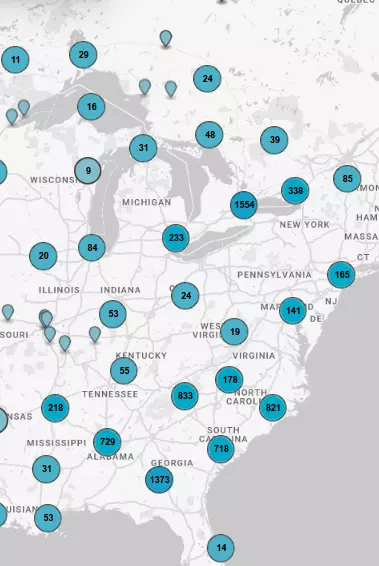EMPORIA--HOME OF WILLIAM ALLEN WHITE
EMPORIA--HOME OF WILLIAM ALLEN WHITE When native- born William Allen White entered college at Emporia in 1884, the city, incorporated in 1857, already was called the Athens of Kansas because...
- kshs
- kansas
KANSAS INDIAN TREATY
KANSAS INDIAN TREATY In 1825 President James Monroe approved a bill providing for the survey of the Santa Fe Trail from Missouri to New Mexico and the making of treaties to insure...
- kshs
- kansas
THE MENNONITES IN KANSAS
THE MENNONITES IN KANSAS Beginning in 1874, hundreds of peace-loving Mennonite immigrants settled in central Kansas. They had left their former homes in Russia because a hundred-year-old immunity...
- kshs
- kansas
THE LANE TRAIL
THE LANE TRAIL Near here the towns of Plymouth and Lexington once stood as outposts on the Lane Trail, approximated today by US-75. Named for abolitionist James H. Lane, the trail was established...
- kshs
- kansas
ALCOVE SPRINGS AND THE OREGON TRAIL
ALCOVE SPRINGS AND THE OREGON TRAIL Six miles northwest is Alcove Springs, named in 1846 by appreciative travelers on the Oregon Trail who carved the name on the surrounding rocks and trees. One...
- kshs
- kansas
THE LONE TREE INCIDENT
THE LONE TREE INCIDENT In 1874 twenty-seven persons were murdered by Indians on the western frontier of Kansas. Several times during the summer warriors broke away from the restraint of their...
- kshs
- kansas
JOHN BROWN COUNTRY
JOHN BROWN COUNTRY Osawatomie - the name derives from a combination of Osage and Pottawatomie - was settled in 1854 by Free-State families from the Ohio Valley and New England. John Brown, soon...
- kshs
- kansas
WACONDA SPRINGS
WACONDA SPRINGS American Indians considered Waconda Springs a sacred site. Translated similarly by other tribes, the name comes from a Kaw word meaning “Great Spirit.” The legend tells of the...
- kshs
- kansas
FRONTIER IN MONTGOMERY COUNTY
FRONTIER IN MONTGOMERY COUNTY The Sturgis Treaty (also known as the Drum Creek Treaty) has been described as a “stupendous wrong,” a “brazen steal,” and a “thoroughly planned fraud.” Signed in...
- kshs
- kansas
COUNCIL GROVE
COUNCIL GROVE Council Grove takes its name from a council of Osage Indians and representatives of the U.S. government that met here in 1825 and ended with a historic purchase. The U.S. paid...
- kshs
- kansas
LA JORNADA POINT OF ROCKS
LA JORNADA POINT OF ROCKS The Cimarron Cutoff, or Dry Route, of the old Santa Fe Trail extended southwest from several Arkansas River crossings to the Cimarron River, a distance of 50 to 60...
- kshs
- kansas
DRUM CREEK THE CIVIL WAR
DRUM CREEK THE CIVIL WAR During the Civil War, militias from both the Union and Confederate sides were stealing the Osages’ cattle, harassing their villages, and blaming the Indians for...
- kshs
- kansas
Robert "Bob" Hicks Street
On Feb. 1, 1965, learning of a Ku Klux Klan plan to bomb his home, Robert Hicks & his family were told by police that they could not protect them. The Klan was furious that Hicks was housing...
- louisiana
- african american
- civil rights
Old Choctaw Trail
Only official state road in Washington Parish until 1843. Choctaw Indians cut trail for trade with tribes in Baton Rouge, New Orleans, Biloxi, & Mobile. White man believed to have used trail...
- louisiana
- native american
Veteran's Park Memorial
DEDICATED TO ALL VETERANS ON 29 MAY 2005 BY THE VETERAN'S MEMORIAL PARK COMMITTEE BYRON W. CORDES - TERRY M HAINES - EARL MacPHERSON ALEN R. MULLIS - JACOB O. SCHOCK - WILLIAM H. SEIBERT ...
Los Rios Street Historic District
- 1794
- 1946
Domke Plaza
Bogalusa's Birthplace
City was born here in 1906 just west of here on Bogue Lusa Creek bank when tents were set for 1st campsite of Great Southern Lumber Co. Portable sawmill was erected to cut lumber to build town and...
1st United Methodist Church
Oldest Methodist Assembly in Slidell. Founded in a brush arbor on Sept. 26, 1887 as Methodist Episcopal Church South. Joined the Louisiana Conference in 1894. Present site dedicated July 16, 1961.
- louisiana
- church
City of Slidell Centennial
Nov. 13, 1888 - Nov. 13, 1988 Named for diplomat and U.S. Senator John Slidell of Louisiana by son- in-law Baron Frederic Erlanger, one of the financiers of New Orleans and...
- louisiana
- railroad
